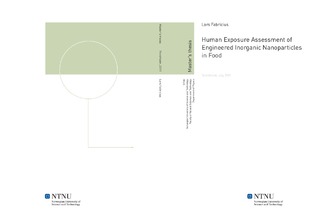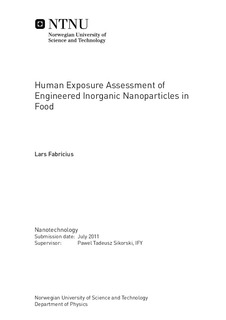| dc.description.abstract | An increasingly important part of food technology is nanotechnology. Inorganic nanoparticles are added directly or indirectly to food in order to create new tastes, appetizing looks or to preserve it longer. Exposure to these nanoparticles is fairly unknown, and there is a need to evaluate the dose that humans are exposed to. In this master thesis, two inorganic substances have been chosen. The first one is silver nanoparticles, commonly known as an antimicrobial agent and added to plastic food containers to preserve food. The second is the food colour E171, titanium dioxide. This is not defined as a nanoparticle because of an average particle size of 200-300 nm, but it is assumed that the size distribution may include nanoparticles. In both cases the intention has been to create an exposure model. For silver, experiments were performed to evaluate the leaching from the food containers to food simulant. The experiments show that first time use of the plastic container will give a concentration in the food simulant of up to a total of 30 ng Ag/g. However, after some use the concentration will be lower than 1 ng Ag/g. The silver experiments show that usage of silver doped food containers will not result in an increase in silver exposure and in general the food containers will not have the claimed antimicrobial effect. However, disposable packaging containing silver may be of concern as the dose of silver leaching from this may be larger.Titanium dioxide data is based on a literature review. Analysis of an E171 sample, showed that up to 50 % of the particles were nanoparticles with a size smaller than 100 nm. Modeling of the exposure to titanium dioxide (TiO2) shows that exposure is diet dependent with an average of 1-3 mg/day/kgbw. The modeling shows that children consume a larger dose than adults, and are more exposed to dietary products containing TiO2. For TiO2 the average dose is larger than the background of 5 mg/day, but lack of an effect threshold makes it difficult to conclude whether this is a unsafe or safe dose.Exposure to inorganic nanoparticles through food will be very dependent on the way of distribution. If added to consumer products the exposure is likely to be less than nanoparticles added directly to the food. Some of the results in this project have been unexpected, like the lack of silver leaching from the plastic containers and a large fraction of nanoparticles in E171. The project only includes two substances and further research into human exposure to other inorganic materials is recommended. | nb_NO |

